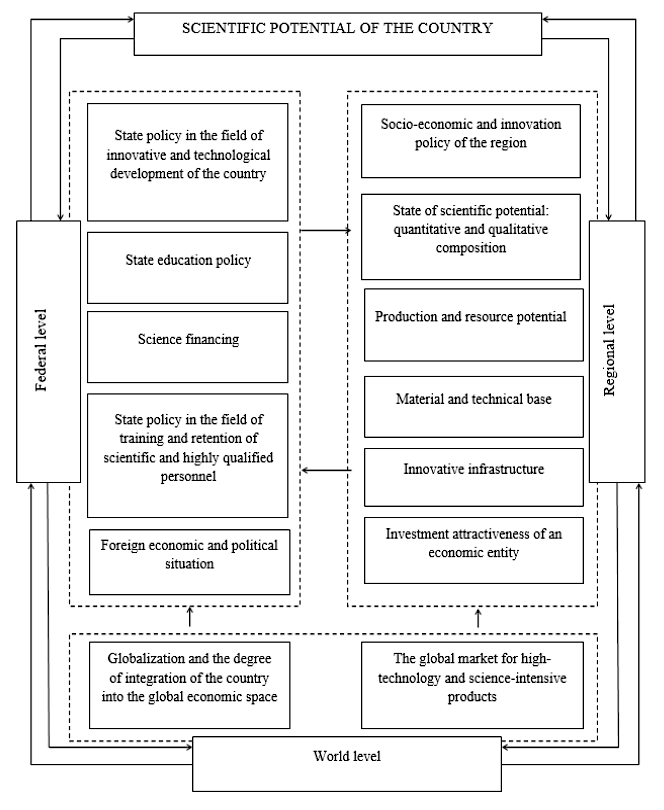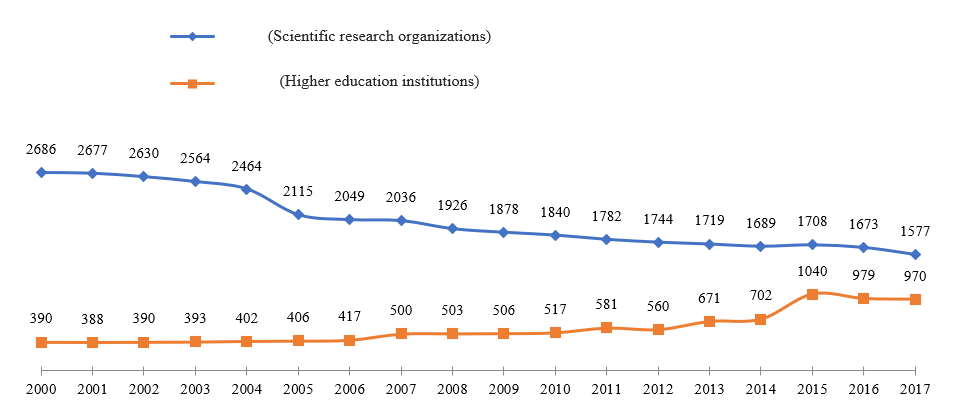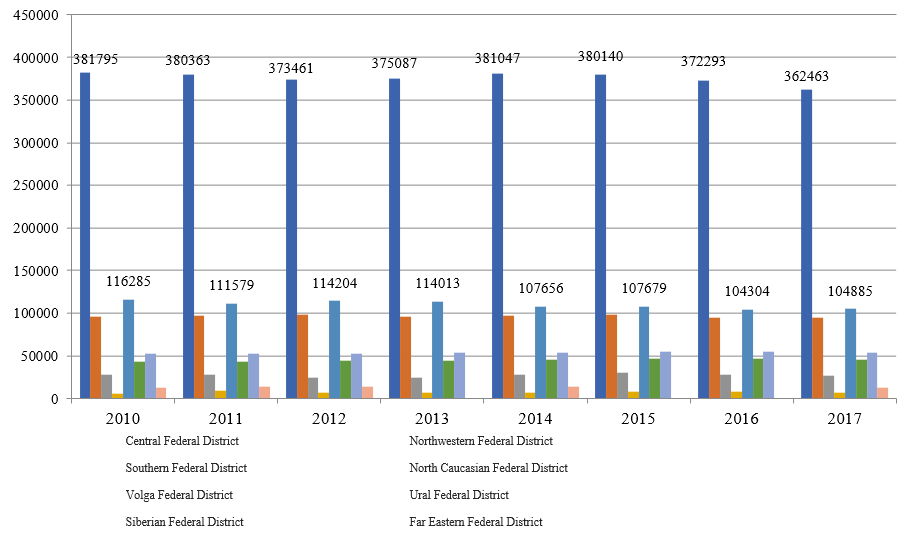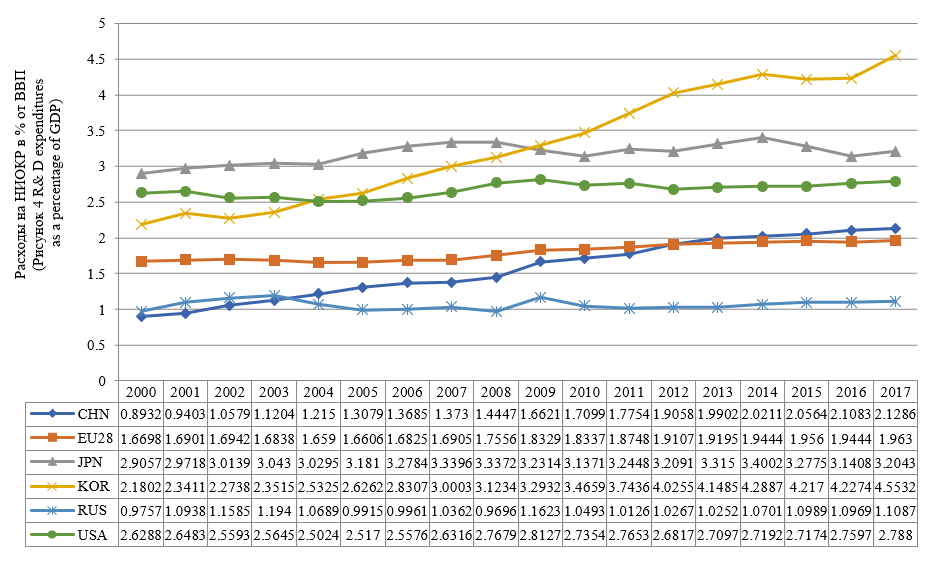Abstract
The article proposes to consider the problem of the formation of the scientific potential of Russia, which is the most important strategic task in modern conditions. The raw material orientation, characteristic of the economy of our country for a long time and determined by the lack of strategic priorities in the development of science and industry, has led to a stable tendency for the negative development of its scientific potential. This study provides an overview of the interpretation of the category of “scientific potential” in the economic literature. The development of scientific potential is defined as the objective reality of the modern stage of development of Russian society. It is shown that the task of modernizing the economy, ensuring a scientific and technological breakthrough can be solved only in the presence of specially trained, highly qualified personnel, as well as the qualitative formation of scientific potential in the future. The article considers factors that influence the development of the country's scientific potential, reflects the practical experience of implementing measures aimed at the development of science, research and development sector and innovative infrastructure. Within the framework of the study, a number of problems were identified, which significantly slow down the process of forming the scientific potential: deterioration of the material and technical base, low capitalization of scientific results, insufficient level of funding for science, etc. In addition, the article recommends measures that contribute to the creation of an effective and efficient state innovation system, the core of which is scientific potential.
Keywords: Innovative potentialinnovative systemscientific potentialstate
Introduction
As world experience shows, rapid economic growth prevails in countries that demonstrate a high level of production of high-tech products. This is quite obvious, since the development and effective implementation of the latest technologies and their use in everyday life provide a solution to complex problems in various fields, such as economics, politics and education, etc. New knowledge convertible into technologies, equipment, and organization of production ranges from 70% to 85% of GDP growth in developed countries.
Scientific potential lies at the basis of the formation of innovative potential, which is designed to provide a technological breakthrough in Russian economy and its transition to a new economic structure.
The implementation of innovative activity involves the use of both scientific and innovative potentials, as well as all entities and institutions that form the country's innovative system, the activities of which are aimed at its implementation and support.
The subjects of the country's innovation system are:
1. Regions. Each region develops its own strategy of innovative development taking into account various resource advantages. Since the country has an uneven territorial distribution of production and resource potential, it is precisely the scientific potential that is crucial for the development of productive forces and the economic prosperity of the region. As an example, we can consider the experience of Japan, a country that is not rich in resources, but creating the conditions for the formation of high-quality scientific potential.
2. Higher school and research centers, where science and education act as a platform for various basic and applied research in support of the government's tasks in the field of innovative development. And the prospects for the development of scientific potential strongly depend on how the reproduction of scientific personnel in the academic environment occurs (Avraamova, 2012). Moreover, universities are looking for new forms of organization of educational and scientific activities, as well as mutually beneficial interaction and cooperation with other business entities (Kurbatova, Kagan, & Vshivkova, 2018).
3. Business community. World and Russian experience indicates that the progressive development of the economy is impossible without the close interaction of science and practice. As a result of such close interaction innovation is born and the development of high-tech production takes place.
Problem Statement
The pace of technological advances observed in the modern world technological space, the speed of such transformations, as well as the commercial and industrial viability of technologies changing against this background reveal the urgent need to solve problems associated with the insufficiently high level of production in our country of high-tech products that can compete in the world market.
The technological lag of the Russian economy, the decline in the competitiveness of industry, including in the field of science-intensive products, the long predominance of raw materials in the country's export structure, as well as the limited opportunities for developing scientific potential, are largely determined by the current policy in the country.
Based on the analysis of domestic and world experience, we can say that the formation and development of scientific potential is the most effective way to increase the competitiveness of the economy and, as a result, solve problems in the field of technological and innovative breakthrough. The intensity of technological and revolutionary developments mainly depends on the field of knowledge based on the intellectual and scientific potentials formed in society and on the involvement of scientists who can make a significant contribution to the development of innovations.
Research Questions
Research involves finding answers to the following questions:
What factors influence the formation of the country's scientific potential?
What is the role of the state in the formation of scientific potential?
What is the state of the country's scientific potential, what measures will improve the situation?
Purpose of the Study
The aim of the article is to consider the problem of the formation of the country's scientific potential in modern conditions and to identify measures that contribute to the creation of an effective and efficient innovation system.
Research Methods
An integrated approach based on the principle of the unity of theory and practice and including modern methods of socio-economic analysis was taken as methodological basis of the study.
Materials from publications of Russian scientists, legal acts, methods of logical analysis and synthesis, generalization, methods of statistical research and documentary analysis were used in the course of the study of the problem.
Findings
In the economic literature, the category of “scientific potential” is analyzed from various points of view, taking into account the specifics of the tasks facing researchers.
Lapaev and Esenbaeva (2011) consider the scientific potential as a set of available resources that the country has for scientific discoveries, inventions and technical innovations, as well as for solving national and international problems posed by science and its applications.
Valinurova (2013) reveals the scientific potential as “the ability of business entities to develop scientific and applied knowledge and determine the main directions of their application in industrial and social practice”.
According to Nesterenko, Gushchina and Reked (as cited in Gaydamakina, 2014). the scientific potential is a system of new knowledge, technologies and other results of research and development, as well as a system of research and educational institutions.
Since the country's scientific potential is formed as a set of scientific potentials of regions, the following interpretation of the concept of the region’s scientific potential as “the set of its intellectual, institutional and material resources capable or contributing to the generation and dissemination of new knowledge, as well as effective borrowing and assimilation of knowledge received from others” has become widespread in the scientific literature (Gaydamakina, 2014).
An analysis of the presented approaches to unlocking scientific potential, regardless of territorial scope, allows us to state that its effective formation and use is the key to technological breakthrough, to the solution of the problems of technological recovery of the economy and its transfer from “standby and gradual development” to “operation mode and long-term development”. This is quite natural, since science today:
covers all areas of society and production;
is the basis for the development of innovation and the generator of ideas;
determines the country's ability to address socio-economic problems and problems;
is able to ensure a breakthrough in the world’s high-tech space and ensure the competitiveness of the national economic system, etc.
The development of the scientific potential of the state, its effective implementation in innovative and high-tech technologies can occur only under favorable conditions created under the influence of various factors (see Figure
Among the factors presented, the state, which acts as the initiator of scientific and technical developments taking into account national interests and security, has the greatest impact on the formation and development of scientific potential. It is the state that determines the priority of national development. The active role of the state in the development of scientific and technological potential, ensuring the rapid development of science and technology, the introduction of the latest technological developments on the world market is largely due to the challenges that have developed on the world market.
Since 2005, a number of measures have been implemented in Russia aimed at developing the country's scientific potential: in 2005, the main directions of the policy in the field of development of the innovation system for the period until 2010 were approved; in 2006, the “Strategy for the Development of Science and Innovation in the Russian Federation for the Period Until 2015" was approved, which implies the implementation of specific measures to solve the tasks set by the state to develop science, the research and development sector, and the formation of innovative infrastructure; “Strategy for the innovative development of the Russian Federation for the period until 2020”, was approved by decree of the Government of the Russian Federation on December 8, 2011 No. 2227-p. In this strategy, the development of human resources in the field of science, education, technology and innovation is among the key tasks; a special place is given to the interaction of science and production.
The implementation of these documents was reflected in the formation of such infrastructure objects as: Skolkovo center near Moscow, Innopolis University and the Innopolis special economic zone in Kazan, created to develop innovative high technologies as well as Technology Transfer Centers (TTCs) focused on the commercialization of scientific results.
It should be noted that similar centers for the development of scientific potential are successfully operating in a number of countries (Silicon Valley in the USA, IDEON Science Park (Sweden); technopolises in Japan, India, China, etc).
As world practice shows, “technology parks and other objects of innovative infrastructure become “growth points” that set the tone and pace for modern socio-economic development, contribute to the formation of the innovative sector, the growth of product competitiveness and the creation of new jobs” (Golova & Sukhovey, 2015).
It is worth noting that 26 Technology Transfer Centers have already been created on the basis of existing institutes of the Russian Academy of Sciences, universities, state scientific centers (SSC) and scientific organizations. Moreover, a modern university is a scientific community that is capable and should generate new knowledge, use it in the process of training specialists, turn them into a ready-made commercial product and actively develop innovative activities (Reznik & Kurdova, 2017).
Considering the state as a key factor influencing the development of scientific potential, we should pay attention to “The passport of the national project “Science” approved by the Presidium of the Presidential Council for Strategic Development and National Projects (minutes of December 24, 2018 No. 16). The development of scientific and scientific-industrial cooperation, the creation of scientific and educational centers is among the priority tasks of the project; special attention is paid to the training of scientific personnel. The planned expenditures from the federal budget amount to 34.3 billion rubles, in 2020 - 40.4 billion rubles, in 2021 - 52.1 billion rubles to achieve the objectives specified in the draft project in 2019.

The implementation of this national project is very timely, given the current dynamics in reducing the number of research organizations in the country (see Figure

The data presented in Figure
The Concept of the federal target program “Scientific and scientific-pedagogical personnel of innovative Russia” for 2014-2020 was approved by Order of the Government of the Russian Federation No. 760-r in 2013, in which considerable attention was paid to the scientific potential of the country. The concept indicates, that the key factor for a successful economy is “an effective system for the reproduction of world-class competitive scientific and research personnel”.
At the same time, high achievements in an innovative economy are accompanied by an increase in demand for highly skilled workers who have not only higher professional education, but also knowledge that allows them to generate ideas and increase innovative activity. In this regard, it is important to consider the number of personnel engaged in research and development. In 2010 the total number of researchers engaged in research and development was 368915 people, and in 2017 it was 359793 people (by 2.5% less). As for researchers with a Doctorate or a Candidate of Science degree, the total number of scientific personnel decreased by 7.4% and amounted to only 103,327 people by 2017 against 111533 people in 2015 (Federal State Statistics Service. Science and Innovation, 2019).
It is necessary to concentrate efforts on the priorities of scientific and technological development, including the training of scientific personnel and researchers to overcome the “big challenges” facing Russia today. There has been not only a 22% reduction in the number of organizations engaged in the training of scientific personnel (from 1,568 units in 2010 to 1,223 units in 2018), but also a significant decrease - by 42% - in the number of applicants in recent years according to statistics. If in 2010 there were 157,437 people enrolled in graduate school, in 2018 it was only 90,823 people. The number of defended dissertations from 9611 units in 2010 decreased by 4.4 times and amounted to 2198 dissertations in 2018 (Federal State Statistics Service. Science and Innovation, 2019).
At the same time, there was a significant decrease in the number of organizations conducting training for doctoral students during this period. The value of this indicator amounted to 213 organizations in 2018, which is 3 times lower than in 2010. In this regard, a downward trend is also characteristic of the number of doctoral students. The analyzed indicator decreased by 4 times by 2018 and amounted to 1048 people compared to 4418 people in 2010. As a result, a corresponding change is observed in relation to the number of defended doctoral dissertations (in 2010 - 336 units, in 2018 - 82) (Federal State Statistics Service. Science and Innovation, 2019).
Moreover, admission to graduate school fell by 49.5%, and to doctoral school by 23.8% in 2010 - 2018 (Federal State Statistics Service. Science and Innovation, 2019).
As it was noted earlier, its own resource supply is characteristic for each region as a key subject of innovation, moreover, it is the regional level that is the most susceptible to innovation, and interaction of science and practice is important at this level.
According to Figure
Moreover, the costs of technological innovation of organizations in the Russian Federation have similar dynamics. The largest volume of expenses in 2017 was accounted for by the Central Federal District - 457472.1 million rubles, in the Volga Federal District - 336919 million rubles. The lowest rates are characteristic of the North Caucasus Federal District, the Far Eastern Federal District and the Southern Federal District (8956.8 million rubles; 58581.8 million rubles and 82,662.6 million rubles, respectively).

Support for young scientists is also taking place within the framework of Decree of the Government of the Russian Federation of April 27, 2005 No. 260 (amended on September 28, 2018) “On measures for state support of young Russian scientists - candidates of sciences and doctors of sciences - and leading scientific schools of the Russian Federation ", which provides: annual competitions for grants, as well as state, financial support of leading scientific schools of the Russian Federation.
Science is financed from the federal budget, and financial resources are allocated annually for fundamental and applied research. In the period from 2000 to 2015, an annual increase in the amount of funds for science was observed, the growth rate was 24% (from 17396 million rubles to 439392 million rubles). However, since 2016 the situation has changed, and in 2017 the financial support of science made only 377882 million rubles, which is by 14% less than in 2015. It is noteworthy that the largest volume of expenditures as a percentage of GDP is observed in 2013 and amounted to 0.58% of GDP, and then there was an annual decrease in the analyzed indicator to 0.41% in 2017 (Federal State Statistics Service. Science and Innovation, 2019).
The draft budget of the country intends to increase financing of basic research: from 153 billion rubles in 2018 to 188 billion rubles in 2019, and then up to 218 billion rubles in 2021 (Federal State Statistics Service. Science and Innovation, 2019).
Despite a slight increase in expenditures, the state still allocates insufficient funds for basic science: the volume of expenditures in 2018 amounted to 0.15% of GDP, and the planned value of this indicator in 2021 should be 0.18% of GDP, which is inferior to the level of both European and Asian countries.
According to the Organization for Economic Cooperation and Development (OECD), R&D expenditures in Russia as a percentage of GDP, despite a slight increase, remain low relative to a number of countries (Figure

Moreover, the unstable dynamics of R&D expenditures as a percentage of GDP is characteristic only for our country as it follows from the data presented in Figure
It is obvious that the formation of an innovative scientific and technological competitive economy in various regions of the world shows that this is a very costly, lengthy, and sometimes difficult process (Maslennikov, 2017). It is impossible to ensure breakthrough development without mobilizing the country's entire resource potential, as well as without coordinating innovation processes.
Conclusion
Thus, the current uncertainty in the external economic environment puts forward new requirements for ensuring the development of the scientific and technological sector of the economy. It is clear that it is necessary to create a favorable innovation environment for all stakeholders, science and business, and coordination of actions at all stages in order to create an effective innovation system.
In order to strengthen the position of the national economy in the world and create an effective and efficient innovation system, it is necessary to do the following:
identify strategic areas and sectors of the economy for their further development and investment;
identify the regions with the greatest innovative potential for the creation of research centers and innovation development clusters;
increase funding for higher education in order to deepen research in all sectors;
focus on the effectiveness of investments in R&D;
finance joint innovative projects of science and practice “science - business community”;
develop a clear mechanism for coordinated and mutually beneficial cooperation between science and practice;
develop a mechanism for coordination and cooperation between regional authorities, science and practice.
Summing up, it should be noted that the technological recovery of the economy is currently possible only by strengthening the role of science and strengthening its interaction with production.
References
- Avraamova, Е. М. (2012). Scientific potential advance in modern Russia. Terra Economicus, 10(1), 156-164.
- Federal'naya sluzhba gosudarstvennoj statistiki. Nauka i innovacii [Federal State Statistics Service. Science and Innovation]. (2019). Retrieved on May 20, 2019 from http://www.gks.ru/wps/wcm/connect/ rosstat_main/rosstat/ru/statistics/science_and_innovations/science
- Gaydamakina, I. V. (2014). Scientific potential of central russia: mathematical evaluation methods. Scientific notes of Orel State University, 3(59), 22-28.
- Golova, I. M., & Sukhovey, A. F. (2015). Innovation and technological development of industrial regions in the conditions of socio-economic insecurity. Economy of Region, 1(41), 131-144.
- Kurbatova, M. V., Kagan, E. S., & Vshivkova, A. A. (2018). Regional development: addressing the problems of building and realization of scientific and technological capacities. Terra Economicus, 16(1), 101-117.
- Lapaev, S. P., & Esenbaeva, A. A. (2011). Essence and classification structure of the mental potential. Vestnik of the Orenburg State University, 13(132), 307-311.
- Main Science and Technology Indicators full database. (2019). OECD Research and Development Statistics Database. Retrieved on 20 May, from http://www.oecd.org/sti/msti.htm
- Maslennikov, M. I. (2017). The Technological Innovations and Their Impact on the Economy. Economy of Region, 13(4), 1221-1235.
- Reznik, G. A., & Kurdova, M. A. (2017). Functions of Russian University During Formation of Innovation-Based Economy. Integration of Education, 21(3), 441-458.
- Valinurova, L. S. (2013). Faktory, principy i usloviya formirovaniya innovacionno-orientirovannyh territorij. Innovacii i investicii, 5, 28-31. [In Russ].
Copyright information

This work is licensed under a Creative Commons Attribution-NonCommercial-NoDerivatives 4.0 International License.
About this article
Publication Date
31 December 2019
Article Doi
eBook ISBN
978-1-80296-076-1
Publisher
Future Academy
Volume
77
Print ISBN (optional)
-
Edition Number
1st Edition
Pages
1-1056
Subjects
Industry, industrial studies, project management, sustainability, business, innovation
Cite this article as:
Amirova, D., Reznik, G., & Sergeeva*, T. L. (2019). Scientific Potential Of The Country: Realities And Problems Of Formation. In I. O. Petrovna (Ed.), Project Management in the Regions of Russia, vol 77. European Proceedings of Social and Behavioural Sciences (pp. 120-129). Future Academy. https://doi.org/10.15405/epsbs.2019.12.05.15
